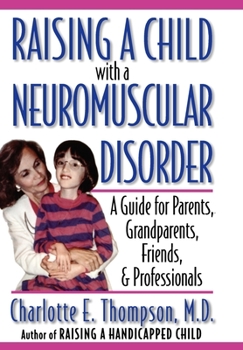Raising a Child with a Neuromuscular Disorder: A Guide for Parents, Grandparents, Friends, & Professionals
Select Format
Select Condition 
Book Overview
Raising a child with a neuromuscular disorder can be a overwhelming experience for even the strongest parent or grandparent. Dr. Charlotte Thompson, a leading authority in pediatric neuromuscular disorders, draws on her 38 years of experience treating children with muscular dystrophy, spinal atrophy, congenital and mitochondrial myopathies, Charcot-Marie-Tooth, and all the childhood neuromuscular disorders. Her book provides not only medical facts...
Format:Hardcover
Language:English
ISBN:0195128435
ISBN13:9780195128437
Release Date:September 1999
Publisher:Oxford University Press
Length:288 Pages
Weight:1.35 lbs.
Dimensions:0.8" x 6.0" x 9.0"
Customer Reviews
2 ratings
This book save my son's life
Published by Thriftbooks.com User , 19 years ago
Dr. Thompson was right. The entire body is a muscle. I followed her words and got a base line exam from every profession. Since my son looks good I was told not to worry. Although, many were surprised that he could walk. I kept asking what about his heart, lungs, gi and eyes. I was told not to worry. I made the appointments with the cardiologist, geneticist, gi, pulmonary, optical. It was no surprise, my son had a hole in his heart, was aspirating, has mild cortical visual impairment. My family (father and uncle's) are misdiagnosed with Charcot-Marie-Tooth Disease (CMT) and we have Myotonic Muscular Dystrophy. Just as Dr. Thompson states, "Don't let any doctor tell you that a specific problem is just a sympton of the disease/condition. Get a proper opinion from a professional in that area."
A must-have book for the affected family, w/minor flaws
Published by Thriftbooks.com User , 25 years ago
Raising a Child discusses all the forms of muscular dystrophy, so JDMS only gets scant treatment. Even so, most of the book is useful and practical. The introduction suggests it not be read cover-to-cover, but used as a chapter-by-chapter reference to find advice on the specific topics covered. Each chapter does stand alone in this way, but parents with a newly-diagnosed JDMS child may want to read the first six chapters right away. The book begins with a description of common reactions to an initial diagnosis: shock, numbness, denial, anger and grief. There are good suggestions for handling these stages, including dealing with stress and having creative and enjoyable outlets for parents and children. Another very useful chapter follows: the author thoroughly discusses getting a correct diagnosis and finding a primary doctor who is both caring and knowledgeable. The author warns us against doctors who are arrogant or controlling or who don't take enough time to diagnose a rare condition. In this case, a second opinion is called for. And in many cases, a specialist may be the best doctor for your child, an option that should be discussed and also should be covered by your insurance. Choosing and communicating with your medical team is crucial, and there are common-sense suggestions such as keeping a notebook, using a tape recorder, and keeping a record of tests. One critical characteristic of good medical professionals is they seek out and respect the observations of parents and children. Parents can also help foster good communication, and there are good suggestions in this area: being on time for appointments, using good phone manners, and giving an occasional thank-you note or small gift. You'll find some good information on dealing with insurance companies in one chapter, including keeping a meticulous paper trail of medical information and insurance documents and finding help, if needed, in handling insurance problems. The author presents some very wise advice on maintaining a perspective wider than the disease; both by remembering your child's other mental and physical health needs and by considering the recreational and emotional needs of all family members who are affected, including the parents. One contribution to your child's sense of well-being and independence comes form his ability to do things for himself, so every step you can make in that direction is very important. Detailed discussions of hygiene, assistive devices, travel and safety considerations make this part of the book very practical. The author includes tips on coping with the emotional ups and downs of your child. Often, children can only express themselves by bad behavior. The best way to deal with children's anger and fear is to pay attention to non-verbal as well as verbal cues and let them know you understand. In some cases, outside help may be a good idea. Other strategies for parents are realistic






